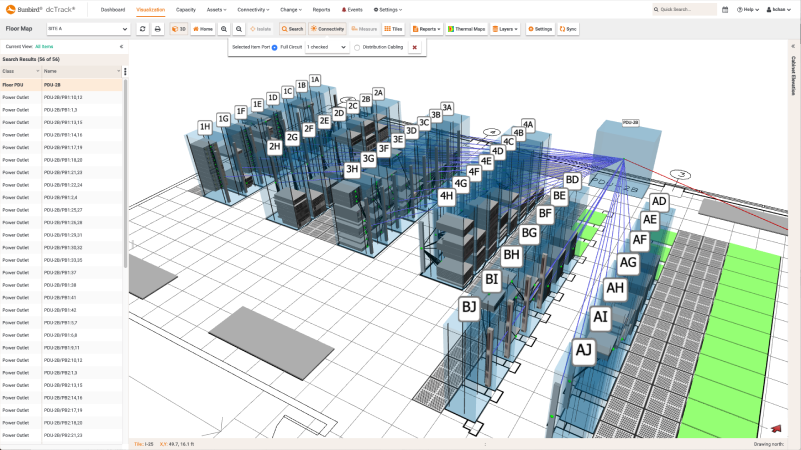
What is Network Documentation?
Network documentation is the practice of maintaining records of computer networks to provide data center managers information about the devices in the data center and how they are arranged.
Some data center professionals rely on outdated network topology diagrams and spreadsheets for their documentation, while Data Center Infrastructure Management (DCIM) software allows for more effective end-to-end network visualization to easily identify single points of failure and decrease troubleshooting time.
What Should Be Documented in a Network?
The Open Systems Interconnection (OSI) model presents a conceptual framework that breaks down network communication into seven distinct layers. The OSI model provides an organizational structure that is a helpful guide when diagramming and documenting the different functions and items in a network. DCIM Software helps to document Layer 1 (Physical) connectivity, port to port.
Layer |
Function |
Documentation |
|---|---|---|
|
Layer 7 (Application) |
Presents data in a user-friendly form |
|
|
Layer 6 (Presentation) |
Converts data from one format to another |
|
|
Layer 5 (Session) |
Establishes, manages, and terminates connections between applications |
|
|
Layer 4 (Transport) |
Coordinates secure data transfer between end hosts |
|
|
Layer 3 (Network) |
Routes data within the network and to other networks |
|
|
Layer 2 (Data Link) |
Transfers data between two directly connected nodes |
|
|
Layer 1 (Physical) |
Physical devices and the connections between them |
|
What is a Network Topology Diagram?
Different topologies have different impacts on performance and stability. The most common topologies are:
- Bus Topology. All devices are connected by one central cable with two endpoints. It is simple and affordable, but vulnerable to downtime for the entire network with difficult troubleshooting.
- Ring Topology. Devices are connected in a circular pattern. The network can run faster than in a bus topology and terminators are unnecessary, but a single failure disrupts the entire network and is hard to troubleshoot.
- Star Topology. A common topology for larger networks. All data passes through a central hub which connects to all other network devices. It is reliable unless the central hub fails, but it can be expensive to set up and use.
- Mesh Topology. A reliable topology where the devices are interconnected and data is transmitted by routing (sent the shortest distance) and flooding (sent to all devices). Since there can be no single point of failure, it is reliable and secure, but it’s complexity results in high costs and lengthy configuration.
- Hybrid Topology. A network that is comprised of two or more topologies. Most commonly found in larger enterprises, hybrid topologies offer flexibility and scalability with the downside of often being complex, difficult to manage, and expensive.
What Are the Benefits of Network Documentation with DCIM Software?
Improving Uptime
An accurately documented network can provide quick diagnosis and impact or what-if analysis in the event of potential network issues or planned maintenance of network equipment.
Optimizing Capacity Utilization
Real-time data gives you an always-accurate picture of usage in your data center, so you can identify stranded capacity, forecast when you will run out, and make the most of your existing resources.
Improve People Productivity
You can manage devices, analyze data center business intelligence with dashboards and reports, and then make data-driven changes – all in a single system, with fewer clicks and mouse movements.
Simplifying Validation
Automatically validate the compatibility of your physical connections. DCIM prevents you from building connections across incompatible ports and when looking to deploy equipment, it will exclude cabinets without enough available, compatible connectors.
What Network Items Can Be Documented in a Data Center Using DCIM Software?

- Carrier Wide Area Networks
- Core Routing or Switching Equipment
- Data Circuits (Ports, Patch Cords, and Cabling)
- Demarcation Points
- Edge Switching (e.g., Top of Rack/End of Row)
- KVM and Serial Console Ports and Connectivity
- Multiplexing Equipment
- Patch Panels
- Rack Layouts
- Servers with Copper or Fiber Data Connection
- IDF Closets
By documenting in DCIM software, you can marry network items in a single pane of glass with other data center objects, such as:
- Busways
- Cabinets
- CRACs
- Environmental Sensors
- Floor PDUs
- Power Outlets
- Rack PDUs
- UPSs
Who Can Benefit from Network Documentation with DCIM Software?
- Data Center Managers
- Data Center Operators
- IT Teams
- Power Teams
- Facilities Teams
- Network Engineering Teams
- Server Teams
- Infrastructure Teams
- Cable Installers
- Data Center Move Teams
- Internal and External Customers
- Storage Teams
Modernize Your Data Center Network Documentation with Sunbird’s Second-Generation DCIM Software
Sunbird’s second-generation DCIM software addresses the challenges of modern data center network documentation with connectivity management that is fast, easy, and complete. With Sunbird’s DCIM, you can visualize all your network and data circuits in 3D, document and understand how your assets are connected down to the port level, and ensure that you always have the most updated and accurate information. Use circuit trace diagrams to display each hop from origin to termination with the details of each connection so you can identify single points of failure and decrease troubleshooting time. Keep your infrastructure well-documented with Sunbird’s DCIM so you can diagnose issues faster and more effectively.
Don’t believe us?
See what our satisfied customers are saying about Sunbird’s data center monitoring capabilities.
Take the Next Step with Sunbird. Try It Free.
DCIM Operations Demo
Remote 3D visualization of all your racks, assets, power, and network connections. View 100+ dashboard charts and reports. Know the capacity of all infrastructure items.
Free 30-Day Trial
Use your own data to take a Free 30-Day Trial with our Award Winning Full Featured DCIM Solution.
See Yourself With Screenshots
Explore our screenshots to see our second-generation DCIM features for yourself.






























